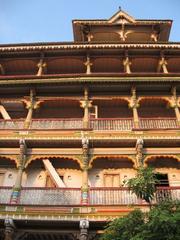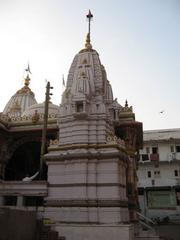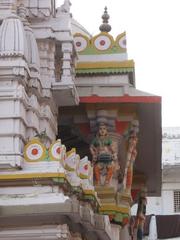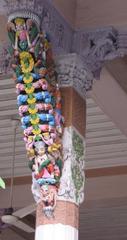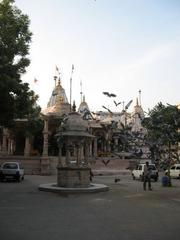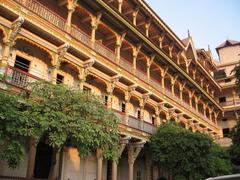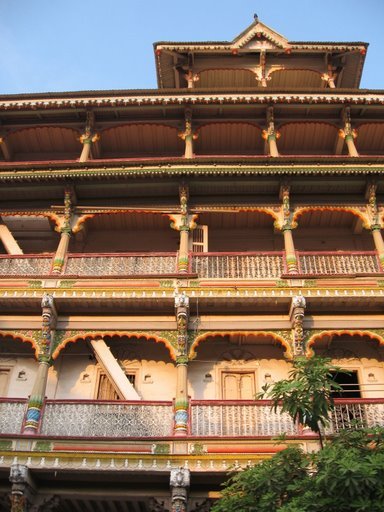
Kalupur Swaminarayan Mandir: Visiting Hours, Tickets, and Historical Significance in Gujarat, India
Date: 15/06/2025
Introduction
The Kalupur Swaminarayan Mandir stands as a spiritual, historical, and architectural landmark in the heart of Ahmedabad, Gujarat. Established in 1822 as the first temple of the Swaminarayan Sampraday, it is revered as both a sacred place of worship and the administrative headquarters of the NarNarayan Dev Gadi. The temple’s establishment, with land gifted by the British Imperial Government and consecration under the guidance of Bhagwan Swaminarayan’s disciple Brahmanand Swami, marked a transformative moment in Gujarat’s religious landscape. Today, the Mandir is celebrated for its intricate Nagara-style architecture, vibrant community life, and rich festival traditions, drawing devotees and tourists from across India and beyond.
For more information on planning your visit, refer to the official temple website, Heritage of Ahmedabad, and Trek.zone.
Table of Contents
- Historical Background and Socio-Religious Role
- Architectural and Artistic Heritage
- Visiting Hours and Ticket Information
- Accessibility and Visitor Facilities
- Special Events and Rituals
- Nearby Attractions
- Travel Tips and Cultural Etiquette
- Preservation Efforts
- Frequently Asked Questions (FAQ)
- Conclusion
Historical Background and Socio-Religious Role
Foundation and Early History
The Kalupur Swaminarayan Mandir was established in 1822, cementing the presence of the Swaminarayan Sampraday in Gujarat. Built on land donated by the British, the temple was constructed under the supervision of Brahmanand Swami and consecrated in the presence of over 50,000 devotees. This event underscored the spiritual and social influence of the sect, which emphasized devotion, ethical living, and community service (Swaminarayan Mandir Kalupur, TravelTourGuru, TheIndia.co.in).
Religious and Cultural Significance
The temple is the headquarters of the NarNarayan Dev Gadi, the northern division of the Swaminarayan Sampraday, and serves as a center for spiritual guidance, religious administration, and social outreach. It enshrines the murtis of NarNarayan Dev, Swaminarayan, Radha-Krishna, and other deities, with elaborate rituals and aartis performed throughout the day. Major festivals such as Swaminarayan Jayanti, Diwali, Janmashtami, and Annakut transform the temple into a vibrant hub of cultural celebration (Trek.zone, AhmedabadTourism.in).
The temple is also notable for its inclusive ethos, with dedicated assemblies and spaces for female devotees, and for its emphasis on community service through food distribution, education, and humanitarian initiatives.
Architectural and Artistic Heritage
Design and Materials
The Kalupur Swaminarayan Mandir is a masterpiece of 19th-century Nagara architecture. It is renowned for its extensive use of Burma teak wood, allowing for intricate carvings that have endured for generations. Every bracket, column, and arch features unique, vibrant colors—creating a kaleidoscopic effect that is both aesthetically stunning and symbolically rich (Heritage of Ahmedabad).
Carvings and Motifs
The temple’s wooden and stone elements are adorned with floral patterns, mythological figures, and geometric motifs, reflecting the rich artistic traditions of Gujarat. These detailed carvings serve both decorative and didactic purposes, illustrating Hindu scriptures and episodes from Swaminarayan’s life (Wikipedia).
Layout and Key Structures
The temple complex comprises:
- The main sanctuary (garbhagriha) housing NarNarayan Dev and Swaminarayan
- Akshar Bhavan, which preserves sacred texts and artifacts
- A multi-story guesthouse with modern amenities
- Subsidiary shrines dedicated to Ganesh, Hanuman, and Shankar
- Courtyards, pillared halls, and the traditional Haveli mansion
During festivals, the temple is further embellished with floral garlands, drapes, and illuminated arches, accentuating its festive grandeur (Heritage of Ahmedabad).
Visiting Hours and Ticket Information
- Opening Hours: Daily, 6:00 AM to 8:00 PM (some sources note extended hours up to 8:30 PM or as early as 5:00 AM for rituals; verify during festivals)
- Entry Fee: Free of charge for all visitors
- Ritual Timings: Key aartis are held at:
- Mangla Aarti: 5:30 AM
- Shangar Aarti: 8:10 AM
- Rajbhog Aarti: 10:10 AM
- Sandhya Aarti: 7:00 PM
- Shayan Aarti: 8:15 PM
For special festival schedules, consult the official temple website.
Accessibility and Visitor Facilities
- Wheelchair Accessibility: Ramps and assistance for elderly and differently-abled visitors
- Restrooms and Drinking Water: Available on site
- Guesthouse: Air-conditioned, with advance booking recommended during festivals
- Medical Clinic: On-site facility for emergencies
- Information Center: Brochures and audio guides available
- Photography: Permitted in outer areas, but generally restricted inside the main sanctum (RoamingVerse)
Special Events and Rituals
The Mandir hosts numerous religious festivals, with Swaminarayan Jayanti, Diwali, and Annakut among the most prominent. These celebrations feature devotional music, processions, community meals (bhandara), and elaborate decorations.
Daily rituals and aartis are open to all, fostering a welcoming and spiritually uplifting environment.
Nearby Attractions
The temple’s central location in Ahmedabad’s Old City makes it an ideal starting point for exploring:
- Jama Masjid: 15th-century mosque, ~3 km away
- Sidi Saiyyed Mosque: Famous for intricate stone latticework, ~2 km away
- Hutheesing Jain Temple: Dedicated to Lord Dharmanath, ~2 km away
- Bhadra Fort: Historic fort complex, ~2 km away
- Calico Museum of Textiles: Premier textile collection, ~3 km away
- Sabarmati Ashram: Gandhi’s residence and museum, ~5 km away
- Kankaria Lake: Recreation spot, ~5 km away
For a complete itinerary, consider guided heritage walks that often begin at or include the Mandir (AhmedabadTourism.in).
Travel Tips and Cultural Etiquette
- Dress modestly (cover shoulders and knees); traditional Indian attire is appreciated
- Remove shoes before entering temple areas
- Maintain silence and respectful behavior, especially near the sanctum
- Photography restricted inside main sanctum; allowed in outer courtyards
- Non-vegetarian food and public displays of affection are not permitted
These practices help preserve the sanctity and harmonious atmosphere of the temple.
Preservation Efforts
Given the temple’s age and the delicacy of its wooden structures, ongoing restoration is vital. Skilled artisans regularly maintain carvings and repaint woodwork, supported by the Swaminarayan Sampraday and heritage organizations. These efforts ensure the Mandir remains a living monument to Gujarat’s religious and artistic heritage (Wikipedia).
Frequently Asked Questions (FAQ)
Q: What are the visiting hours of Kalupur Swaminarayan Mandir?
A: Daily, 6:00 AM to 8:00 PM (verify for festival changes).
Q: Is there an entry fee?
A: No, entry is free for all visitors.
Q: Are guided tours available?
A: Yes, via the temple administration or local heritage tour operators.
Q: Is the temple accessible for differently-abled visitors?
A: Yes, with ramps and assistance.
Q: Is photography allowed?
A: Permitted in outer areas, restricted inside the main sanctum.
Q: What are the biggest festivals celebrated here?
A: Swaminarayan Jayanti, Diwali, Janmashtami, and Annakut.
Conclusion
The Kalupur Swaminarayan Mandir is a living blend of spirituality, culture, and artistic achievement. Its welcoming atmosphere, daily rituals, vibrant festivals, and proximity to Ahmedabad’s historical sites make it an essential destination for both pilgrims and travelers. Whether you seek spiritual solace, architectural inspiration, or a glimpse into Gujarat’s living heritage, this Mandir offers a memorable and enriching experience.
For the latest information, special event updates, and online resources, visit the official temple website, Heritage of Ahmedabad, and Trek.zone.
Download the Audiala app for personalized guides, festival updates, and in-depth content on Gujarat’s spiritual and cultural landmarks.
References
- Swaminarayan Mandir Kalupur
- Trek.zone
- Heritage of Ahmedabad
- TheIndia.co.in
- TravelTourGuru
- AhmedabadTourism.in
- Wikipedia
- RoamingVerse
